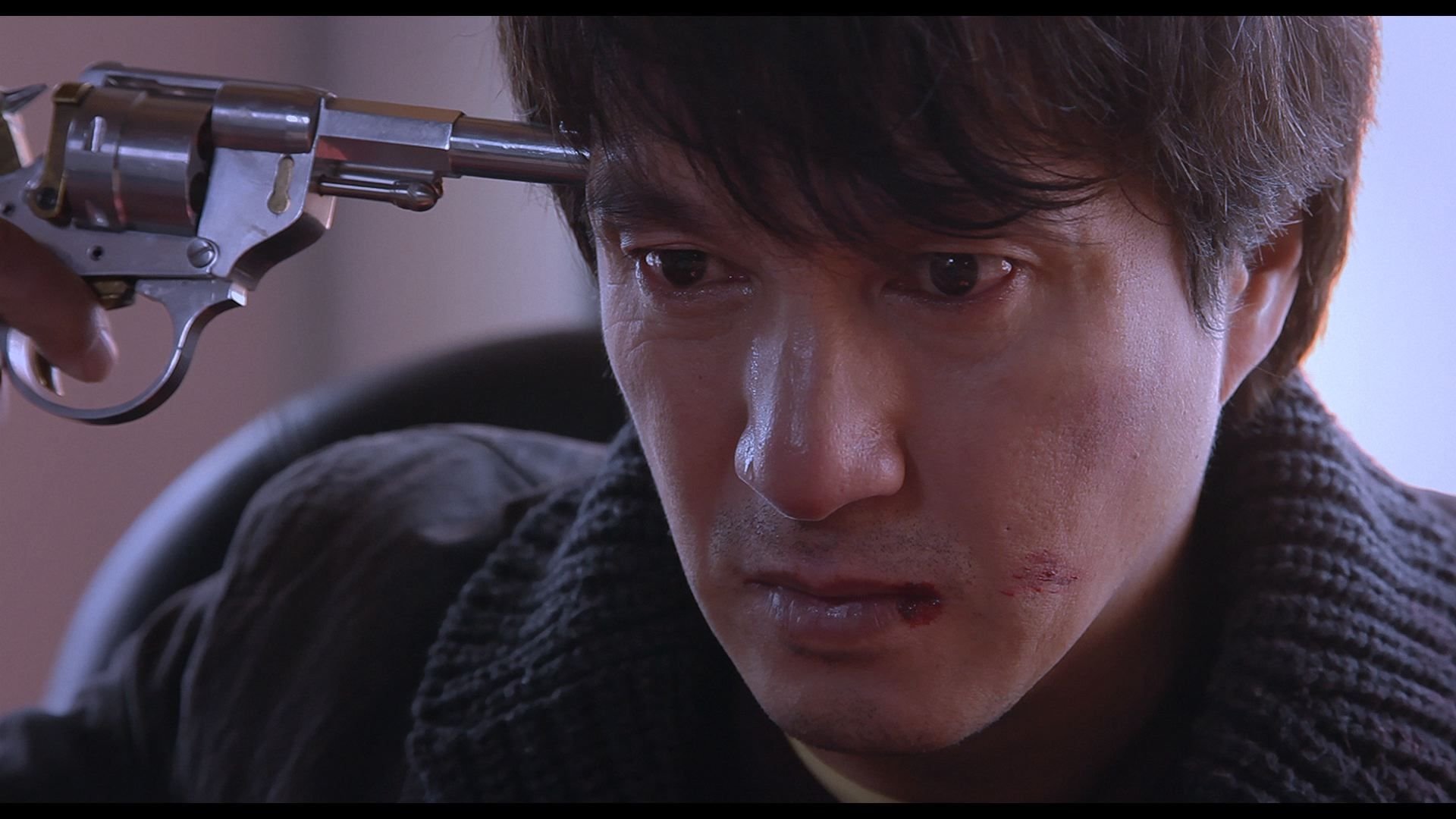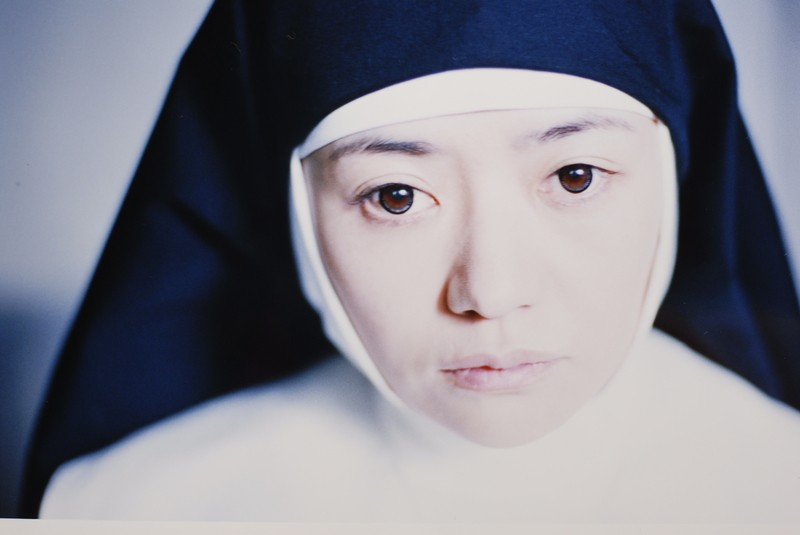18. Wild Zero (Tetsuro Takeuchi, 1999, Japan)
Ace is a youngster who idolizes the noise-garage band Guitar Wolf, permanently following them through their live shows. During an incident involving a skirmish between the band and a club owner, the leader of Guitar Wolf recognizes the rock potential of Ace, subsequently turning him into blood brother. Almost simultaneously, UFOs invade Earth, transforming people into zombies and using them as foot soldiers.
Tetsuro Takeuchi, a former music video director, cast the members of the actual, aforementioned band and incorporates their music in the film, thus resulting in a movie that looks like an extreme punk video-clip. Beer, drugs, guns, swords emerging from guitars slicing UFOs in half, nude women, and transgender love are all present in “Wild Zero” and covered in blood.
Takeuchi directed a film that dances around comedy and horror and is as erratic as the music of the band.
19. Riki Oh: The Story of Ricky (Ngai Choi Lam, 1991, Hong Kong)
“Riki Oh” is based on a Japanese anime movie and has reserved a place in cinema history for being one of the first movies that was rated for Adults Only, exclusively due to its violent scenes, although it did not incorporate any erotic ones.
In 2001, all prison facilities are privatized. Riki, who was convicted for murdering a Yakuza who was responsible for his girlfriend’s death, arrives in one. Soon he realizes that a gang of four runs the particular prison, each being responsible for a sector and the corrupt guards are in a league with them. Riki, who cannot tolerate their oppression, eventually has to face them.
Ngai Choi Lam directs a genuine splatter film, where the script, the direction and the acting exist solely to service the gory action scenes. Those, however, are surprisingly impressive and graphic, completely capturing the aesthetics of the original ones from the anime. Bloodbaths, torture, superhuman powers, kung fu and the omnipresent low budget, amount in one of the foremost extreme films of its era.
Louis Fan Siu Wong, who plays Riki, was only 18 at the time and eventually managed to become a star in Hong Kong, appearing in movies like “Ip Man”.
20. Vampire Girl vs Frankenstein Girl (Yoshihiro Nishimura, 2009, Japan)
Another filmmaker who could not be left off this list is Yoshihiro Nishimura, the master of the contemporary Japanese splatter film. This specific film is one of his distinct ones.
Monami is an adolescent vampire, who roams the world with no purpose, apart from killing whomever she meets along her way. Eventually she arrives at a school where she enrolls as a student, and shortly after she falls in love with a classmate of hers, Mizushima. However, she does not notice that Keiko, another student and the daughter of the professor of physics and vice principal, is also in love with Mizushima.
The aforementioned professor, Kenji Furano, secretly conducts experiments in the school’s basement, in order to build the ultimate human killing machine. For that purpose, he uses human parts from students his assistant and school nurse bring him after killing them. Furthermore, Monami tricks Mizushima and turns him into a vampire.
What makes Nishimura’s films stand apart in the genre is their technical superiority, a fact resulting from the years he spent working in the special effects, costume and make-up departments. This becomes evident primarily in the battle scenes that are quite impressive.
Additionally, in this particular film, he incorporates a number of minor social remarks regarding Ganguro and the phenomenon of students committing suicide. However, he presents those through his preposterous, satirical view that also encompasses constant bloodbaths.
21. Miss Zombie (Sabu, 2013, Japan)
In a world where zombies have become pets, a cage with one of them arrives in Dr. Teramoto’s house. Her guidelines mention that her name is Shara and that she should not be fed meat, just fruit and vegetables.
Shizuko, the doctor’s wife, who he does not seem to appreciate, orders her to scrub the courtyard and feeds her with rotten food, a practice repeated every day. Additionally, Shara’s daily routine also includes a gang of youngsters that attack her every day and Kenichi, the youngest son of the family, who constantly takes pictures of her.
Eventually, a few issues arise. The courtyard does not seem clear up, one of the family bodyguards rapes Shara (which arouses similar desires to the doctor), and Shizuko forces the zombie to turn Kenichi into a zombie to save him after a mortal accident.
Sabu’s film differentiates because he presents an everyday life that simply includes zombies, instead of the usual attack to humans. Additionally, he directs a minimalistic movie in pace, image and sound, whose aesthetics are similar to the ones of the art house films.
The extremity in “Miss Zombie” lies with its two female protagonists. Ayaka Komatsu as Shara manages to manifest overwhelming sexuality under her grotesque appearance and is equally impressive upon her transformation from a weak-minded marionette to a character moved by altruism and love. Makoto Togashi as Shizuko presents a constant sense of evil and violence, just by her facial expressions and her body stance. Her transformation to a hysteric mother is equally sublime.
22. Moebius (Kim Ki Duk, 2013, South Korea)
Kim Ki Duk’s foremost hideous production was so grotesque, that the Korean Media Rating Board initially banned it completely, before the director cut a number of scenes.
A spouse discovers her husband is having an affair and in order to reciprocate, she decides to castrate their only son and even eats the severed member before she runs away. The shame-faced father thus starts spending his time inquiring about penis transplants on the Internet, while the son, who is being bullied for his situation, ends up participating in a gangbang rape of his father’s former mistress.
Kim’s obvious purpose was to shock his audience and he definitely succeeded in doing so. Almost every onerous notion is present in “Moebius”, including self-torture, misogynism and Oedipal inclinations. Adding to the sense of perversion erupting from the movie is the almost complete absence of dialogue, a tactic meant to force the spectator to focus on the images.
23. Helldriver (Yoshihiro Nishimura, 2010, Japan)
“Helldriver” is another preposterous splatter film by Yoshihiro Nishimura, this time engaging on zombies.
Taku and his sister Rikka are a couple of roaming sadistic murderers who eventually decide to kill her abandoned husband. During the act, his daughter Kika arrives and attacks the couple. Subsequently, a meteorite falls on Rikka, releasing a toxic gas that transforms every resident of northern Japan into a zombie, and her into their queen.
Some years later, the country is split in half by a wall that separates the healthy population of the south part from the zombies in the north. The government hires Kika, who is now a skilled zombie killer, to lead a team of outlaws to the north, to kill the zombie queen.
Nishimura, as usual, incorporates as much absurdity as possible in the film, starting with the movie’s titles that appear after almost half an hour has passed. Furthermore, the zombie boxer, the guards with the peculiar helmets, and a fighting scene involving a kind of pole dancing are only a few of the irrational scenes and notions appearing here.
Nishimura’s usual aspects are also present: constant bloodbaths, surreal humor, impressive battles and a rudimentary effort for social remark, specifically concerning drugs and racism.
Eihi Shiina as Kika is remarkable as usual.
24. The Whispering of the Gods (Tatsushi Ohmori, 2005, Japan)
This particular movie engages the theme of Christianity in Japan. However, the presentation is so onerous that the director was forced to screen it in a mobile, traveling theatre, bypassing the Motion Pictures Ethics Comittee.
The movie wastes no time in presenting what is about to follow, since in one of the initial scenes, a priest is praying while a young retainer gives him a hand job. The cleric’s name is Kamiya and he is the leader of this community that practically functions as a farm, although its rules are those of a Christian monastery. The attendant is Rourou, who has found refuge in the community due to his former crimes, as is the case with plenty of the staff.
The only prerequisite for an individual to join is to accept the authority and the discipline that, in this case, are translated as systematic abuse from the superiors to the workers. The only one who seems untouched by the rules is Rourou, who takes advantage of it all.
Tatsushi Ohmori presents the relationships between the members of the community, where a number of extreme sexual acts are incorporated, including forced fellatio and bestiality. Moreover, a plethora of blasphemous events are taking place in the farm.
Evidently, the film is tough to watch due to its obscenity, and the slow pace of Ohmori’s direction adds to the fact. However, beyond that, “The Whispering of the Gods” incorporates a number of magnificent shots in the snow and the two protagonists, Hirofumi Arai as Rou and Renji Ishibashi as Father Kamiya, act with utter competence.
25. Tokyo Zombie (Sakichi Sato, 2005, Japan)
This preposterous and surreal movie revolves around two workers at a fire extinguisher plant: Fujio, who has an Afro, and the bald-headed Mitsuo. The two spend most of their shift slacking instead of working, a practice that entails jiu-jitsu practice.
When their boss discovers them, they accidentally kill him and dump his body in a toxic waste field, called Black Fuji. Subsequently they run away in a van; however, through Black Fuji, an army of zombies emerges and begins to attack the living. The two protagonists struggle to survive the onslaught by using their jiu-jitsu techniques.
Sakichi Sato directs a film that starts as a comedy about zombies, yet quickly becomes a post-apocalyptic splatter film. Nevertheless, the comic and slapstick elements never leave the picture. Beyond that, “Tokyo Zombie” incorporates significant violence, a number of minor sociopolitical remarks and B-movie aesthetics, all of which result in a peculiar, however extreme zombie farce.
Author Bio: Panos Kotzathanasis is a film critic who focuses on the cinema of East Asia. He enjoys films from all genres, although he is a big fan of exploitation. You can follow him on Facebook or Twitter.







